George Hodel and Juliet Man Ray Letters: 1980s Correspondence and a Meeting in Paris
February 7, 2018
Los Angeles, California
“Je me souviens des jours ancients, et je pleure.” “I remember the old days, and I cry.”
George Hodel in his letter to Juliet Man Ray dated 27 July 1983
Prior to this article, the last public documented communication between the Man Ray’s and George Hodel occurred in the early 1950s and was the postcard response to George from their home in Paris. (Shown below) A copy of which was published in my original investigation, Black Dahlia Avenger (Arcade 2003)
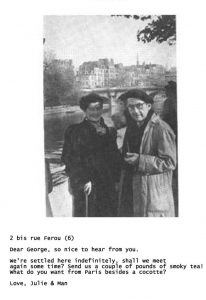
Man Ray photo of Juliet and Dorothy “Dorero” Hodel taken in Hollywood in 1944
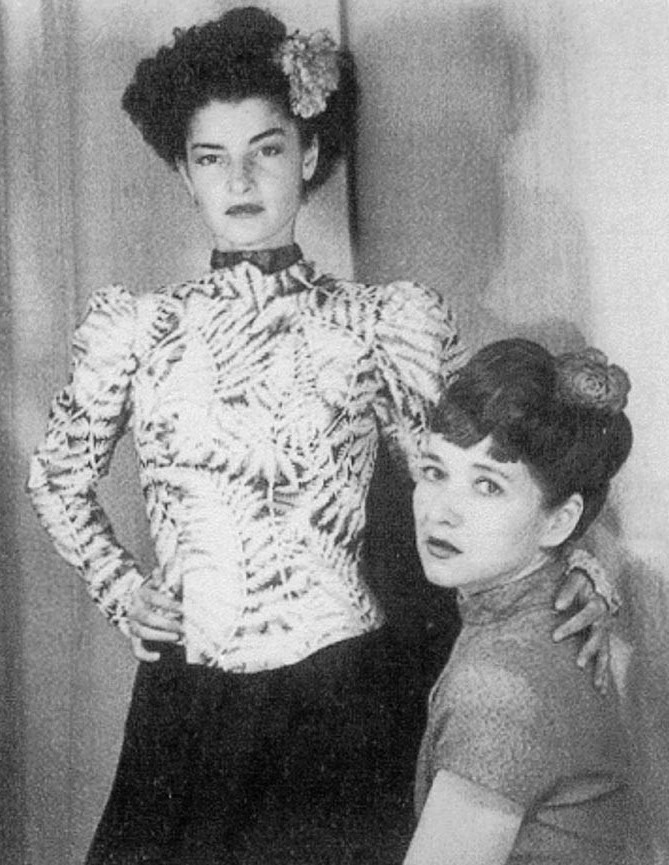
DR. GEORGE HILL HODEL’S JULIET MAN RAY LETTERS (First Public Publication)
In November 1976, Man Ray died in Paris at the age of 86. His wife, and muse, Juliet then 65, survived him by fifteen years dying in Paris in 1991.
In October 1980 some four years after Man Ray’s death, Dr. George Hill Hodel, who had been a close personal friend to both during their “Hollywood Years” (1940-1951) wrote the following letter to Juliet at her home in Paris.
Letter 1- Request for authentication of Man Ray Gift to GHH (August 7, 1980)
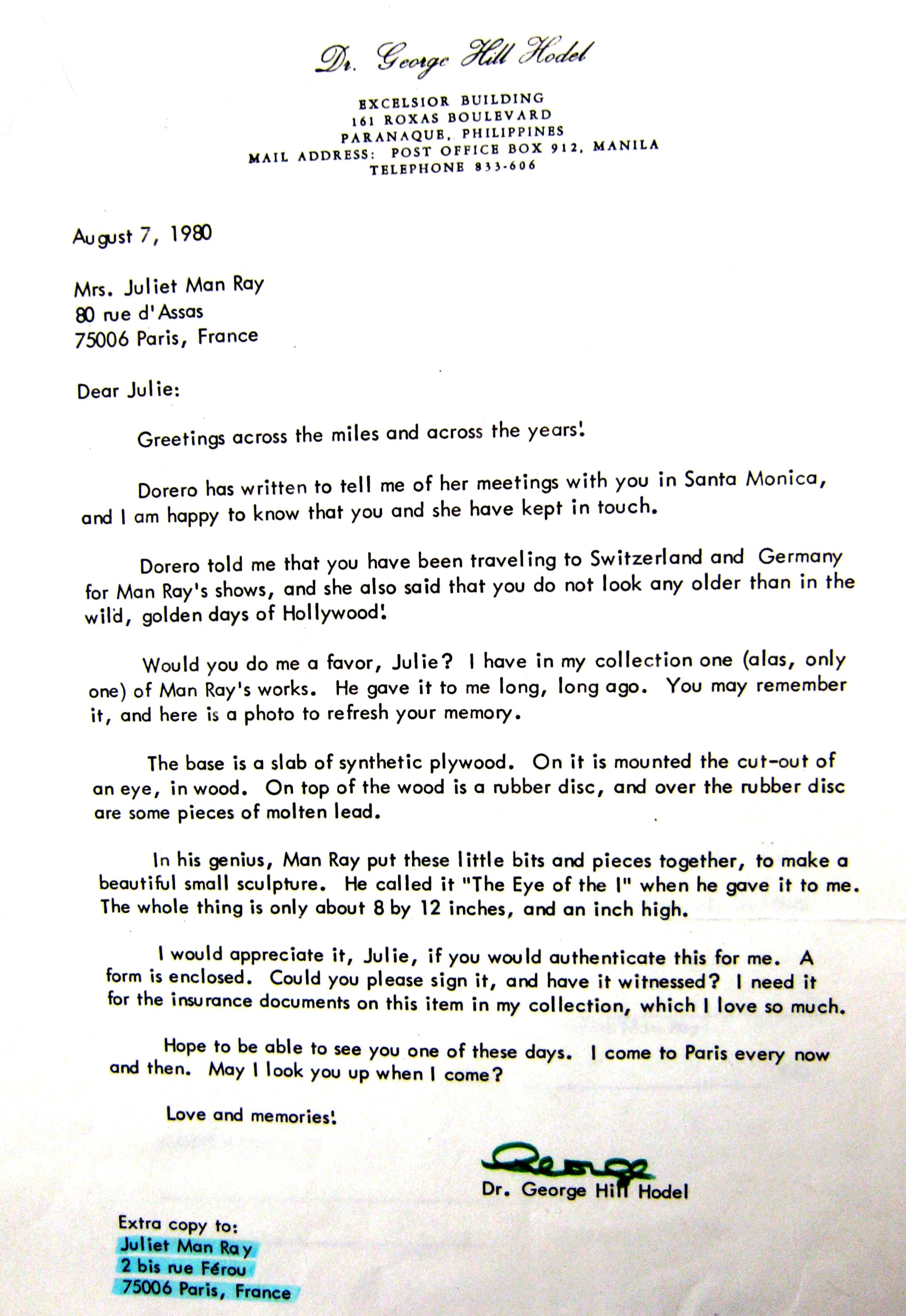
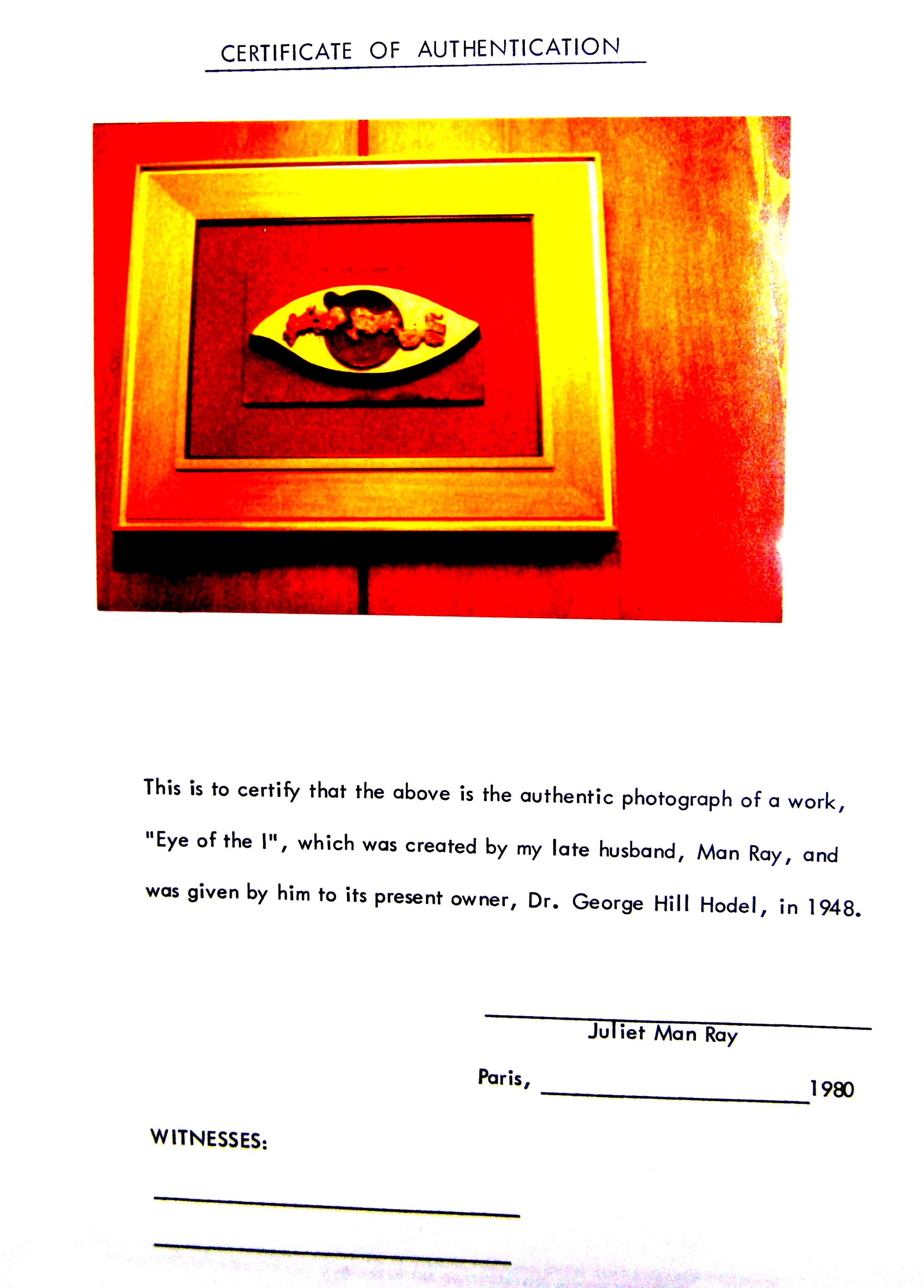
Copy of authentication which accompanied letter and was signed by Juliet and returned to GHH in 1980.
Letter No. 2- Mailed to Juliet in Paris on October 6, 1980. (Request for appraisal of Man Ray sculpture)
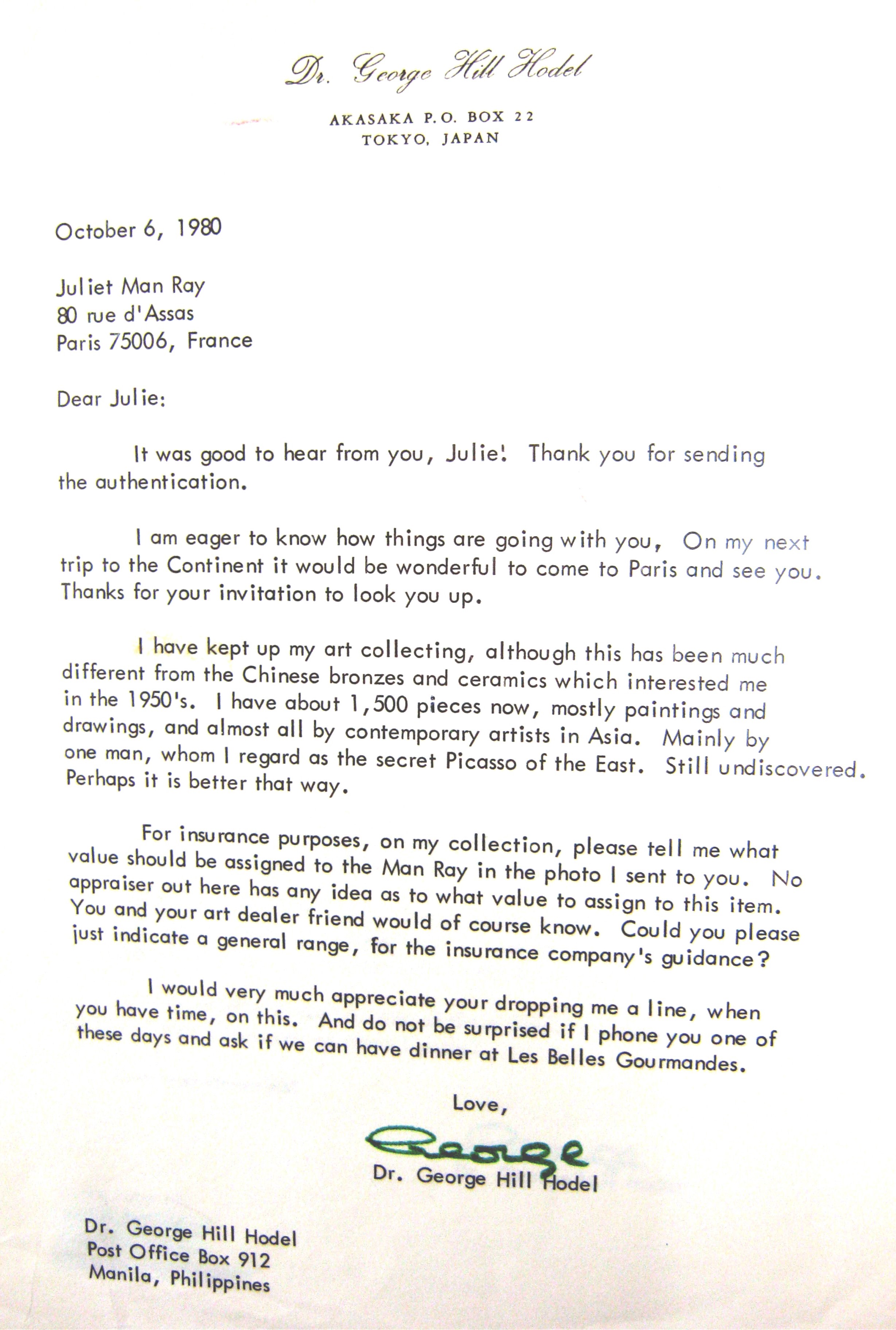
Letter No. 3 (Two-page letter mailed to Juliet on July 27, 1983 from GHH Penthouse Suite on Manila Bay)
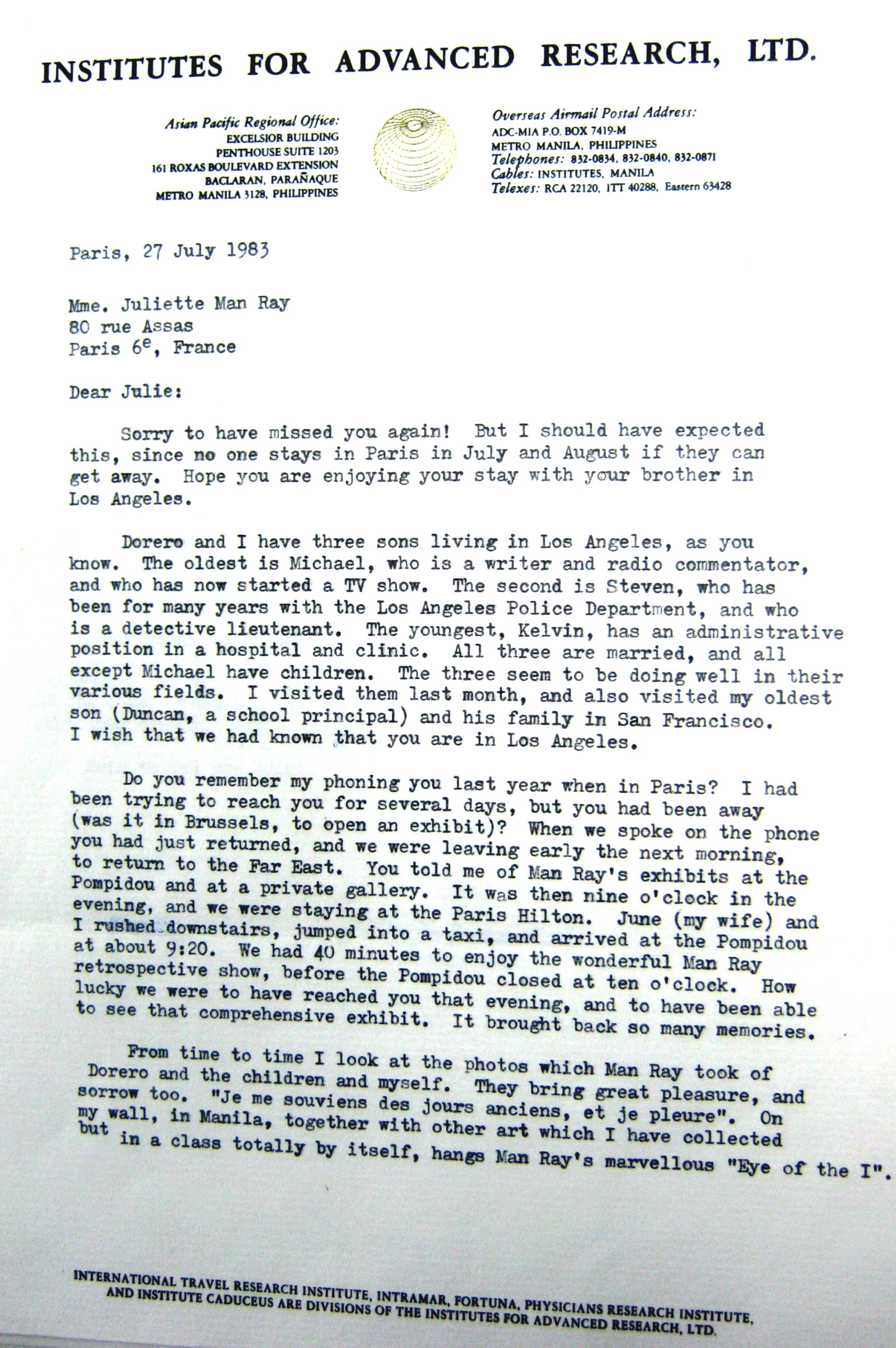
“Je me souviens des jours ancients, et je pleure.” “I remember the old days, and I cry.”
Translation of GHH French statement to Juliet in Letter No.3
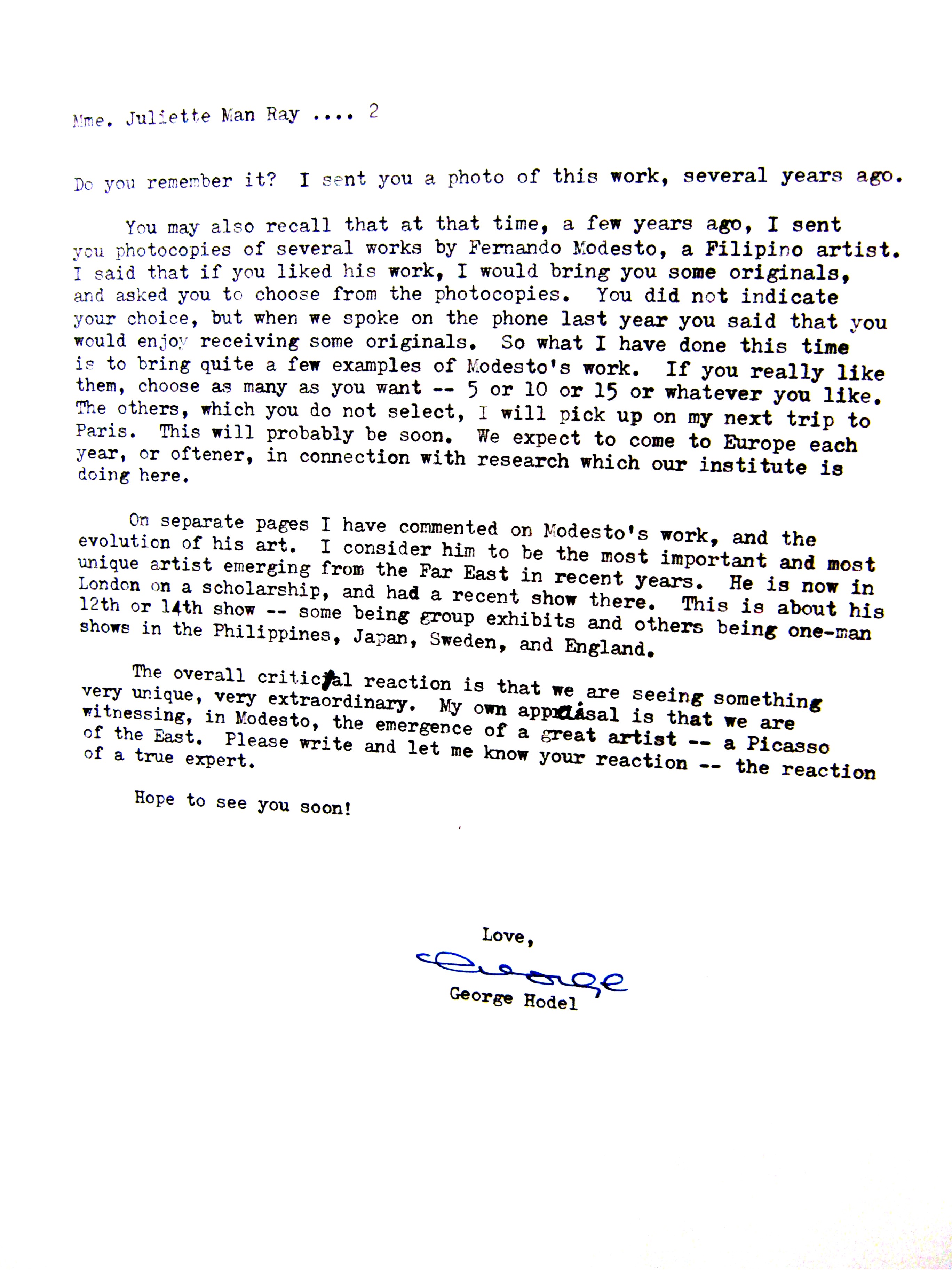
Letter No. 4 (February 25, 1984, Mailed to Juliet in Paris from GHH Manila penthouse)
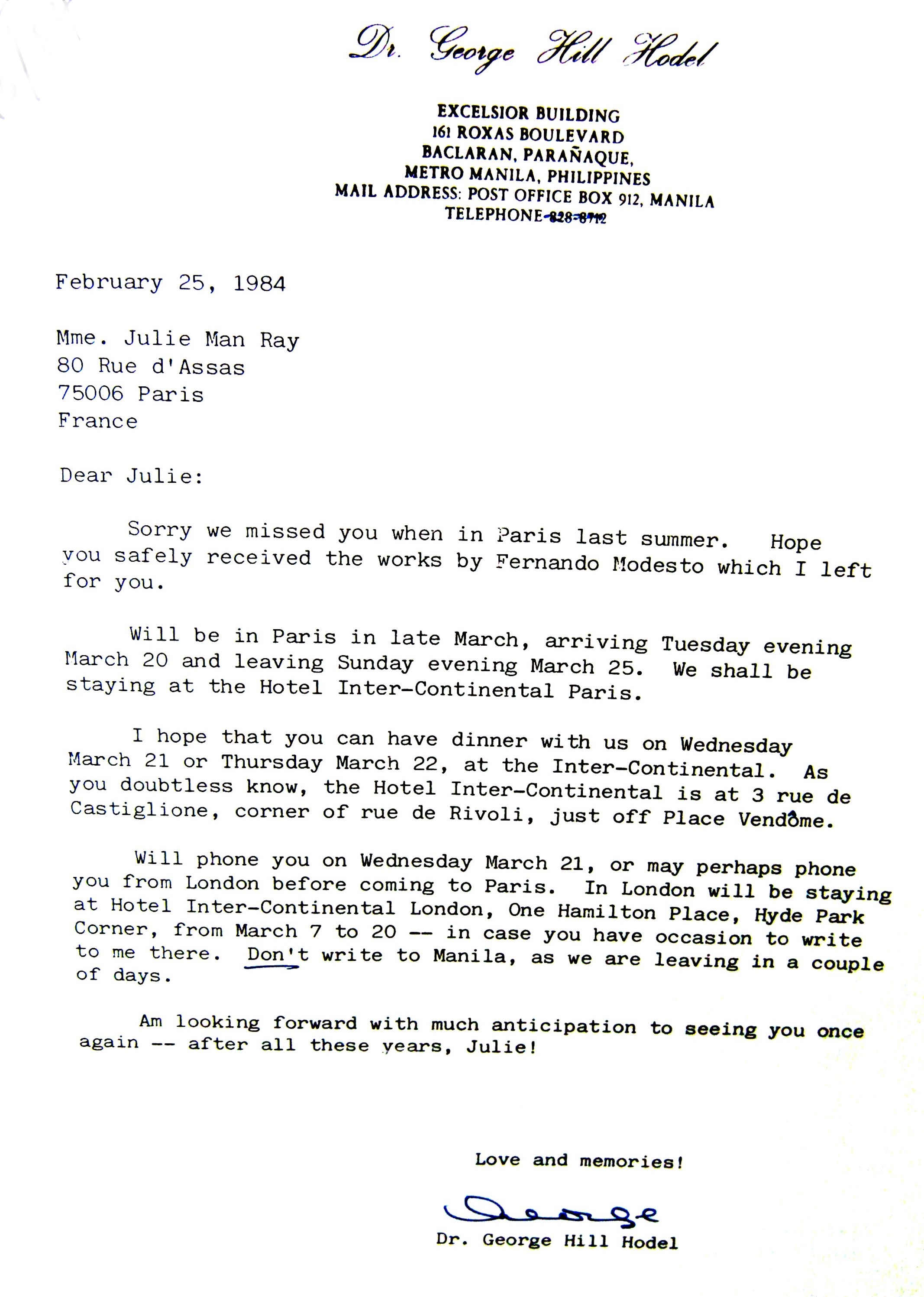
Letter No. 5 (March 25, 1984, mailed to Juliet from Hotel Intercontinental Paris)
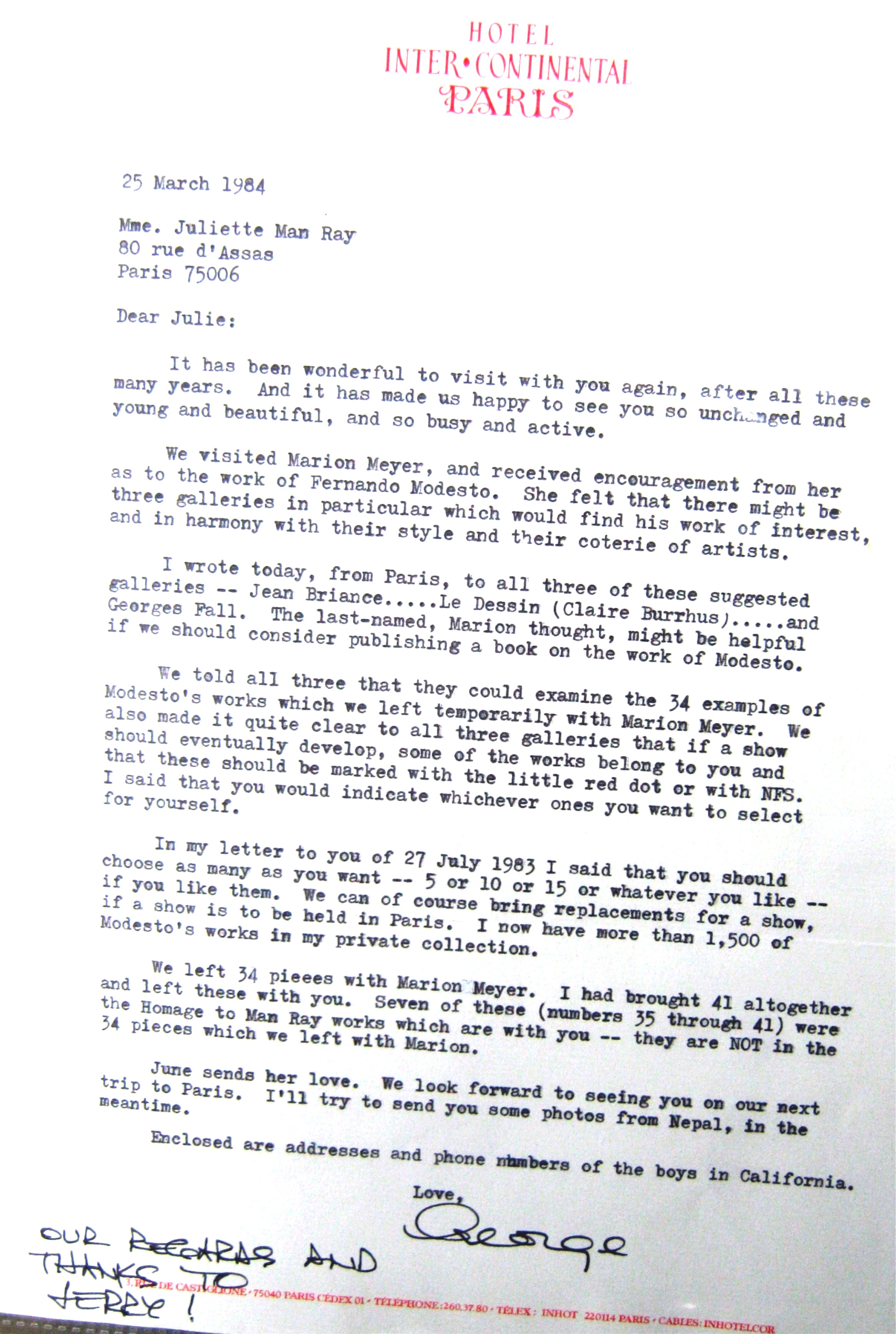
In these letters to Juliet GHH states his belief that Filipino artist, Fernando Modesto is destined to become “The Picasso of the East” and has gifted her more than three dozen of his works, clearly hoping for a personal endorsement from Juliet and hopes for a blessing from her artist and gallerist friends in Paris.
(By 1984, GHH had acquired more than 1500 separate drawings and sketches from Modesto, which he had collected through the years. Many of the works were erotica. I describe “Modesto’s Lovers” in detail in Black Dahlia Avenger which is clearly a macabre reproduction/imitation of Man Ray’s Les Amoureux, The Lovers. As reported in BDA, June Hodel informed me that George and she hand delivered copies of the Modesto drawings to Juliet when they met in Paris.
This conflicts with my original investigation in BDA where I mention the George/June’s visit to Juliet but believed it occurred after the Modesto Lovers was created which I incorrectly read and dated as “1986.”
This contradiction in dates has caused me to reexamine the low-resolution photograph I took at June’s apartment back in 1999, a month after my father’s death when I was assisting her to try and catalog the massive Modesto collection.
In reviewing the drawing, I now see I apparently misread the date which appears to be 1982, just two years BEFORE George and June’s visit with Juliet in Paris.
Either way, it does not affect what the Modesto Lovers drawing depicts, which, to my eye, is an alternate and highly violent and erotic and macabre version of Man Ray’s original.
In Modesto’s replication, we are shown a much darker theme. Man Ray’s “Lovers” now have become violent in the extreme.
The woman’s lipstick now appears to be dripping blood, with three erect male phalluses overhead backgrounded with a woman’s vagina and ejaculations. (Male spermatozoa.) The drawing has been transformed into Sexual Violence and Rape.
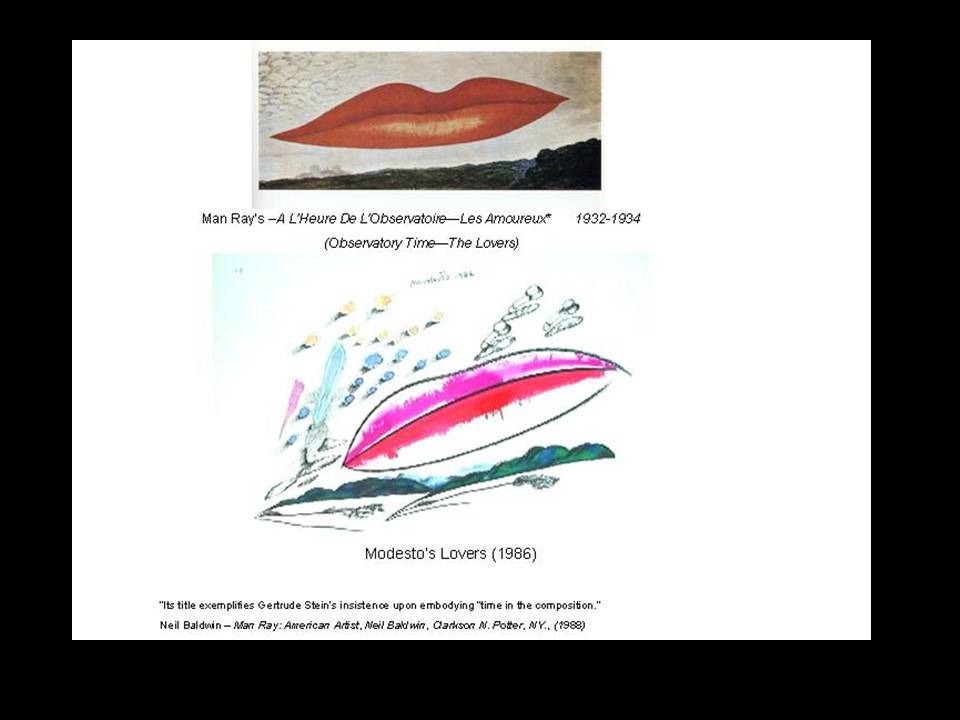
Modesto Lover’s drawing (now believed signed in 1982) compared to Man Ray’s original Les Amoureux (Lovers) 1932
SKH Note:
The 1948 sculpture that GHH refers to in his letters to Juliet which he states was gifted to him from that Man Ray , who called it ” The Eye of the I” was originally exhibited in 1944 as “L’Oculiste”. The sculpture was put up for auction (Butterfield and Butterfield) by GHH and June just prior to his death in 1999. Asking price, “$30,000 to $50,000.” See Butterfield’s full description below:
February 9, 2018, Update to post:
Received below observation/sourcing from my good friend Mssr. Yves Person in Paris just now. Yves, of course, was the high school teacher that “cracked the code” on the Ogham cipher as published in Most Evil II. (Rare Bird Books 2015)
Hello Steve,
“Je me souviens / Des jours anciens…” is a quotation from “Chanson d’automne”, an excerpt from Paul Verlaine’s Poèmes saturniens. Some line(s) of the poem was (were) used by French Resistance as an encoded broadcast message given throughRadio Londres.
When we read such letters, we can’t imagine how dark GHH’s inner self was.
Y.
Verlaine was one of Baudelaire’s main literary heirs, a very great poet.
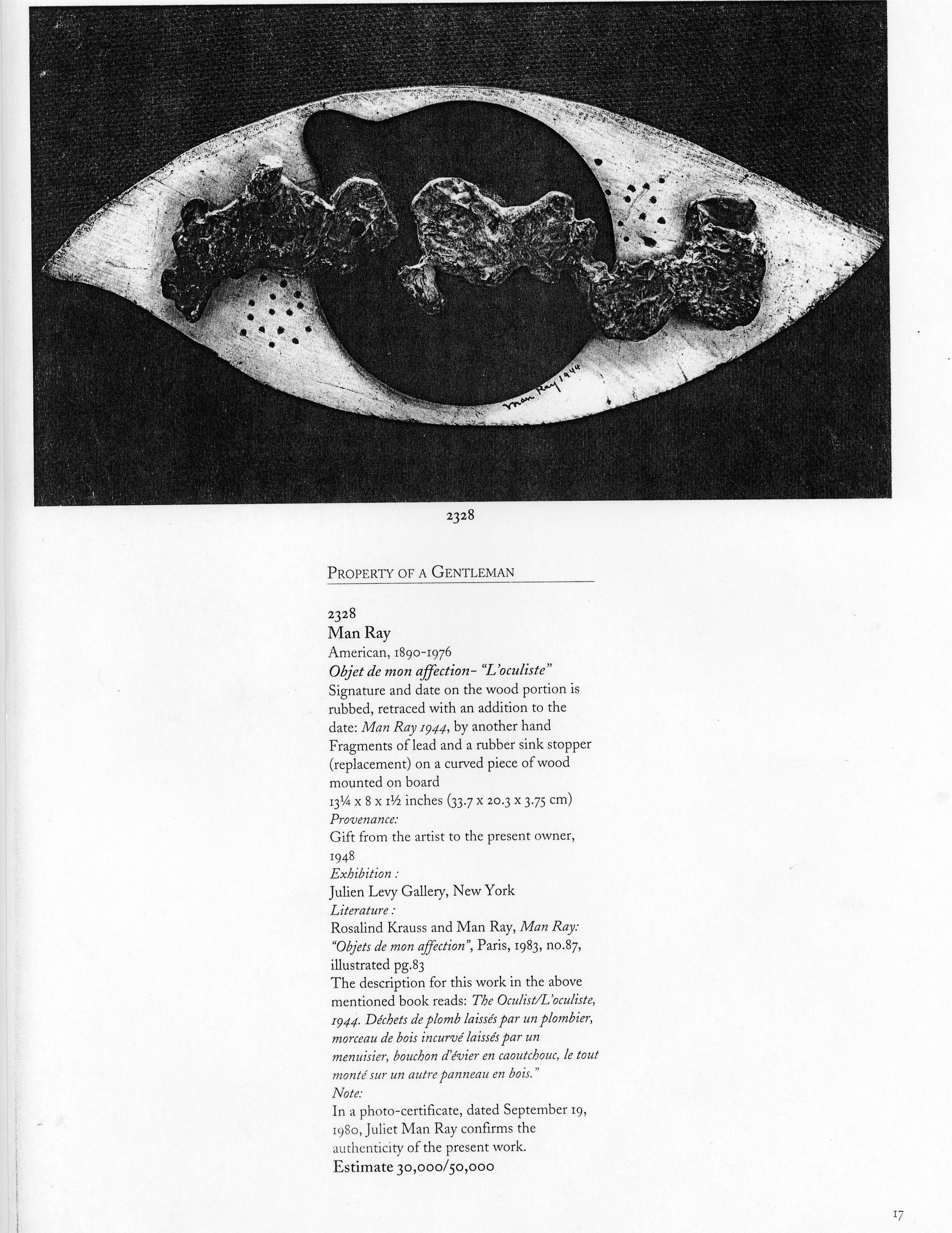
Once again, your theories about these works being inspired by Man Ray, or outright Man Ray tributes is actually confirmed.
It’s amazing how many of your “thoughprints” get independently and inarguably confirmed over time.
Hi Brian: Yes, so much has been independently confirmed through the years since the original publication in 2003. The doors keep opening even to this day. Hard to believe I’m working on the fifth book now. Best, SKH.
Steve:
I notice that one of the five companies making up GHH’s grandly-named “Institutes for Advanced Research” (Letter No. 3) is called “Fortuna.” From the WIkipedia entry on the “Rota Fortunae:”
In medieval and ancient philosophy the Wheel of Fortune, or Rota Fortunae, is a symbol of the capricious nature of Fate. The wheel belongs to the goddess Fortuna (Greek equivalent Tyche) who spins it at random, changing the positions of those on the wheel: some suffer great misfortune, others gain windfalls. Fortune appears on all paintings as a woman, sometimes blindfolded, “puppeteering” a wheel.
Sounds familiar.
LW
LW: How Fortunate.
Steve:
Another reference for the Lady Doom is likely Man Ray’s 1946 readymade, “La Fortune III.” The vaguely anthropomorphic (and misogynistic) contraption combines a “Wheel of Fortune” similar to the red, greeen, white and yellow versions shown inside the comic book with a toilet roll dispenser (shades of Duchamp’s “Fountain.”) Note also that the “PEEK-A-BOO / YOU ARE DOOMED” calligramme in the Halloween Card is written so that it can also be read as “PEEK-A-BOO / YOU ARE DOO — MED.”
We might connect the scatalogical aspect here to the mysterious “L = Conc. on Excreta” note in the pre-suicide JH briefing agenda from 1999 (obliquely referenced in IATN’s “Aloha” episode). “Life = concentrate on excellence” would make more sense in context — e.g., the following line, where GHH compares himself to Michael Jordan going out at the top of his career. But he seems to have literally veered off into the secret disillusion hinted at in the “Sparrows” letter in writing down the words.
-LW
Hi Steve, Long time no writing from me. Are you familiar with Carmina Baruna? This piece of music conducted by Carl Orff has as it’s most famous centerpoint “O Fortuna” sung in Latin – a language I don’t know. It seems like a piece of music describing various wild dances and orgies. Also in the L.A. Confidential movie “Wheel of Fortune” sung by Kay Starr is prominent. I still think the L.A. Confidential movie comes very close to showing your father, of course using a different name, Pierce Morehouse Patchett, played by David Strathairn and the fact that they shot some scenes inside the Sowden House adds to this idea. Anyway, it’s strange how what goes around comes around, sometimes over and over again like being on a giant wheel. More pieces of the puzzle just continue to fall into place. The Most Dangerous Game has come up on recent discussions on some Youtube channels I follow. I tried to get the attention of the main person regarding your books citing The Most Dangerous Game, but I have been unable to make contact as I don’t use Facebook nor Twitter.
Best wishes always, Kathy
Dear Steven,
Your good friend and mine, Carole, forwarded this to me, and as in the above notes, I am amazed how your theories pan out time after time. Since reading your book in 2003, and having sent the odd email or posted comment on to you, I have continued to be taken with the various locations in my neighborhood (in the case of the Sowden House, the fascination with Wright buildings pre-dated my Hodel consciousness) but passing by DuCommun Street where someone else was found, and the building at Santa Monica and Virgil where “someone” said to a witness “I know who killed the Black Dahlia” doesn’t fail to shock and touch me. I finally saw the sunny and lovely corner on 39th and Norton after the MLK Parade last month–don’t know why I hadn’t checked it out after other years’ events in Crenshaw neighborhood. Often I muse on the direct line through Normandie from one place to the other. In these letters you print here, one can’t help but notice how obsequious and interested in Juliet Mr. Hodel was. As your code-breaker implied, the contrast between persona he sets forth, and his reality is notable. Have you ever written about how June reacts to your findings, and also how you feel about fictionalizations like John Gregory Dunne’s (overly emphatic of the racism of the 40’s) TRUE CONFESSIONS? If so, can you tell me where to find them? Thanks once more for settling history, and doing right by the victims! Sincerely, Marilyn Fuss
Hi Marilyn: Thnaks again for the kind words. Much appreciated.
No, never have written about June. Fact is, she has cut off all communication since my long telephone call with her (3 hours) back on January 15, 2003. She was the first person I notified about my findings and investigation, some three months prior to BDA’s publication. She, of course, denied the possibility stating, ‘Your father was a scholar and healer. This is not possible.” That was the last words she shared with me. Have lost all track of her and don’t know if she is in the U.S. or returned to Japan? Very sad.
The fictionalizations are what they are. They have combined through the decades to help build the myths of Elizabeth Short’s public persona. Of course both “True Confessions” and then Ellroy’s later novel, “Black Dahlia” both did great damage to her reputation and created the falsity of her being a drugged out prostitute etc. None of which was true. (I haven’t seen the 2006 De Palma, Black Dahlia movie, but assume it was true to Ellroy’s book and cast Elizabeth in the same dark light?) Oddly, or rather appropo to a real “Hollywood Ending” now with fifteen years of investigation and four published books the true story completely overwhelms the fictionalized versions. The Truth has taken us far beyond where any screenwriter or novelists mind could go. Impossible to think up this “ending”. Take the truth far stranger than fiction findings that resulted from just “following the evidence” to any studio and they’d laugh you off the lot. or call for the men in the white suits to come lock you up. Only in L.A. Only in Hollywood.
All my best, Steve
Congrats on the journey becoming public with Patty working the story on TNT. This appears to be so much darker than ever known, and now it will have its day in the light.
RSC: To be clear, the TNT miniseries is pure fiction and not the true story. Fauna never met my father nor was she ever at the Sowden/Franklin House during his lifetime. The miniseries has nothing to do with my investigation, and I was not involved in any of the consulting/production. An eight hour podcast, “Root of Evil” will air starting Feb 13th. Suggest you check that out for the true story. Regards, steve
Enjoying the podcast “Root of Evil”. Do you believe that Julie Man Ray knew that your father was involved in the Black Dahlia murder? Surely, with his love for the Surrealists, he would have hinted to Man Ray that the crime scene was his “masterpiece.”
The correspondences are very interesting. Curious to know, do you think that Julie Man Ray replied to all those letters?
Terrence M: Thanks. Yes, the Exec. Producer Zak Levitt (Cadence 13) has done a masterful job of editing the interviews and putting it all together. As to your questions: Yes, I am absolutely positive that Juliet KNEW after the fact. They all did. In my later books I present the evidence that not only did his fellow surrealists/dadaists KNOW but they took it a step further and paid back homage to GHH in their own separate works. Duchamp in his “Etant Donnes” (1969); William Copley in his “It is Midnight Dr. ____.” (1961) and Man Ray in his “Minotaur” (1969). See summaries on all three at this blog link:
https://stevehodel.com/2017/01/15/70th-anniversary-black-dahlia-retrospective-why-most-lapd-and-da-law-enforcement-officers-past-and-present-agree-case-solved-chronology-of-new-evidence-linkage-2006-2017/
I think Juliet, knowing what she knew was likely both horrified and terrified of hearing from George Hodel. Expect she would done anything to avoid a meeting with him in Paris? After Man Ray’s death I know she visited my mother “Dorero” in Los Angeles sometime in the late Sixties or early Seventies.
To be a fly on the wall during that conversation. Regards, Steve